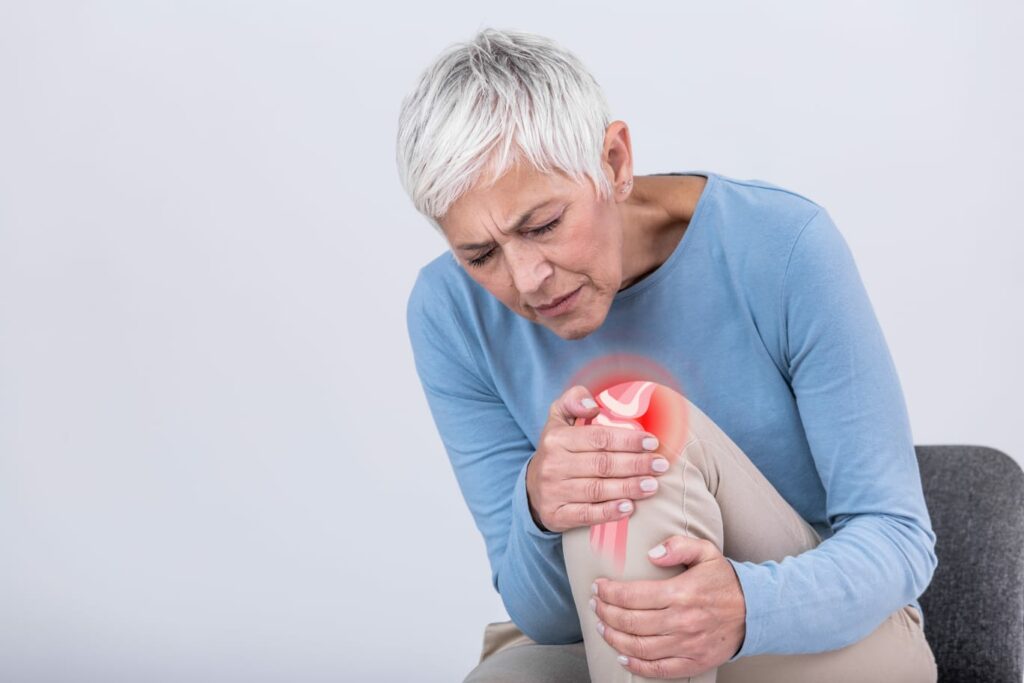Osteoarthritis: Understanding the Condition, Nutrition, and Lifestyle Recommendations
Osteoarthritis (OA) is the most common form of arthritis, affecting millions of people worldwide. It is a degenerative joint disease that occurs when the protective cartilage cushioning the ends of bones wears down over time. This leads to pain, stiffness, swelling, and decreased mobility in affected joints, most commonly in the knees, hips, hands, and spine.

Causes and Risk Factors of Osteoarthritis
Osteoarthritis develops due to a combination of factors, including:
- Age: The risk of OA increases with age as the body’s ability to repair cartilage diminishes.
- Obesity: Excess weight adds stress to weight-bearing joints, accelerating cartilage breakdown.
- Joint Injuries: Trauma or repetitive stress injuries can predispose joints to OA.
- Genetics: A family history of osteoarthritis increases the likelihood of developing the condition.
- Gender: Women are more likely than men to develop OA, especially after menopause.
- Joint Overuse: Repeated joint stress from occupations or sports can increase the risk.
Symptoms of Osteoarthritis
The common symptoms of OA include:
- Pain and stiffness in affected joints.
- Swelling and tenderness.
- Reduced flexibility and range of motion.
- Grinding or clicking sounds during joint movement.
Nutrition Recommendations for Osteoarthritis
Proper nutrition plays a critical role in managing osteoarthritis. It can help reduce inflammation, support cartilage health, and maintain a healthy weight to ease stress on joints.
1. Anti-Inflammatory Foods
Incorporate foods that fight inflammation to alleviate joint pain and swelling:
- Omega-3 Fatty Acids: Fatty fish like salmon, mackerel, and sardines, flaxseeds, walnuts, and chia seeds.
- Fruits and Vegetables: Berries, oranges, spinach, kale, and broccoli are rich in antioxidants and anti-inflammatory compounds like vitamin C and polyphenols.
- Spices: Turmeric (curcumin), ginger, and cinnamon possess natural anti-inflammatory properties.

2. Bone and Cartilage Health
Focus on nutrients that promote joint and bone health:
- Calcium and Vitamin D: Low-fat dairy, fortified plant-based milks, tofu, almonds, and sunlight exposure for vitamin D synthesis.
- Vitamin K: Found in green leafy vegetables like spinach and kale; supports bone mineralization.
- Collagen-Boosting Nutrients: Bone broth, chicken, and foods rich in vitamin C (citrus fruits, bell peppers, guavas) support collagen production.
3. Weight Management
Maintaining a healthy weight reduces the burden on weight-bearing joints. Opt for high-fiber, low-calorie foods like whole grains, legumes, and non-starchy vegetables to aid in weight control.
4. Avoid Pro-Inflammatory Foods
Limit or avoid foods that can worsen inflammation and joint pain:
- Processed and sugary foods (cakes, cookies, and sugary beverages).
- Trans fats and saturated fats found in fried and fast foods.
- Refined carbohydrates such as white bread and pasta.
- Excessive alcohol and sodium.
Lifestyle Recommendations for Osteoarthritis
Adopting a healthy lifestyle can significantly improve quality of life for individuals with OA. Here’s what to focus on:
1. Regular Physical Activity
Exercise strengthens muscles around joints, enhances flexibility, and reduces stiffness. Engage in:
- Low-Impact Aerobic Exercises: Swimming, cycling, or brisk walking reduce joint stress.
- Strength Training: Building muscle around affected joints stabilizes them and reduces pain.
- Flexibility Exercises: Yoga and tai chi improve balance and joint flexibility.

2. Physical Therapy
Consult a physical therapist for targeted exercises to improve joint function and manage pain.
3. Joint Protection Techniques
Use assistive devices like braces, shoe inserts, or canes to reduce joint strain. Modify daily activities to minimize joint stress.
4. Adequate Sleep and Stress Management
Chronic pain can disrupt sleep. Prioritize good sleep hygiene and stress-relief techniques such as mindfulness, meditation, or deep breathing.
5. Hot and Cold Therapy
Applying heat can relax stiff joints, while cold packs reduce swelling and pain.

The Role of Supplements in Osteoarthritis Management
Certain supplements may benefit individuals with OA:
- Glucosamine and Chondroitin: Support cartilage repair and may alleviate symptoms.
- Omega-3 Fatty Acid Supplements: Reduce inflammation in joints.
- Vitamin D and Calcium: Essential for bone health, particularly in older adults.
- Curcumin: Found in turmeric, it acts as a natural anti-inflammatory agent.
Always consult a healthcare professional before starting any supplements, as they may interact with medications.
Conclusion
Managing osteoarthritis effectively requires a multifaceted approach, combining proper nutrition, regular physical activity, and lifestyle adjustments. By focusing on anti-inflammatory foods, maintaining a healthy weight, and adopting joint-protective strategies, individuals with OA can reduce pain, improve mobility, and enhance their quality of life. Early intervention and consistent efforts go a long way in slowing disease progression and preserving joint health.



